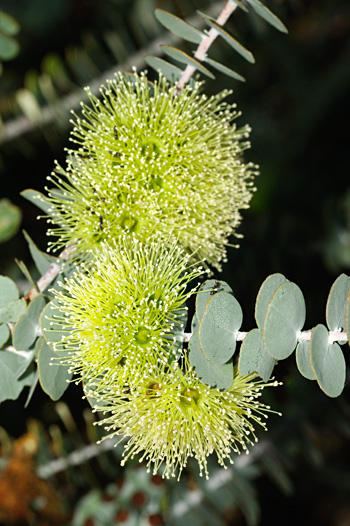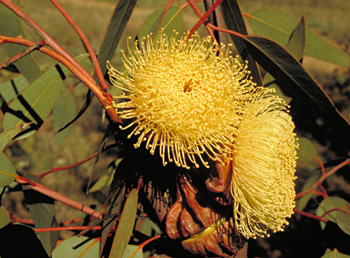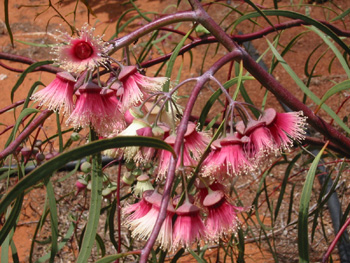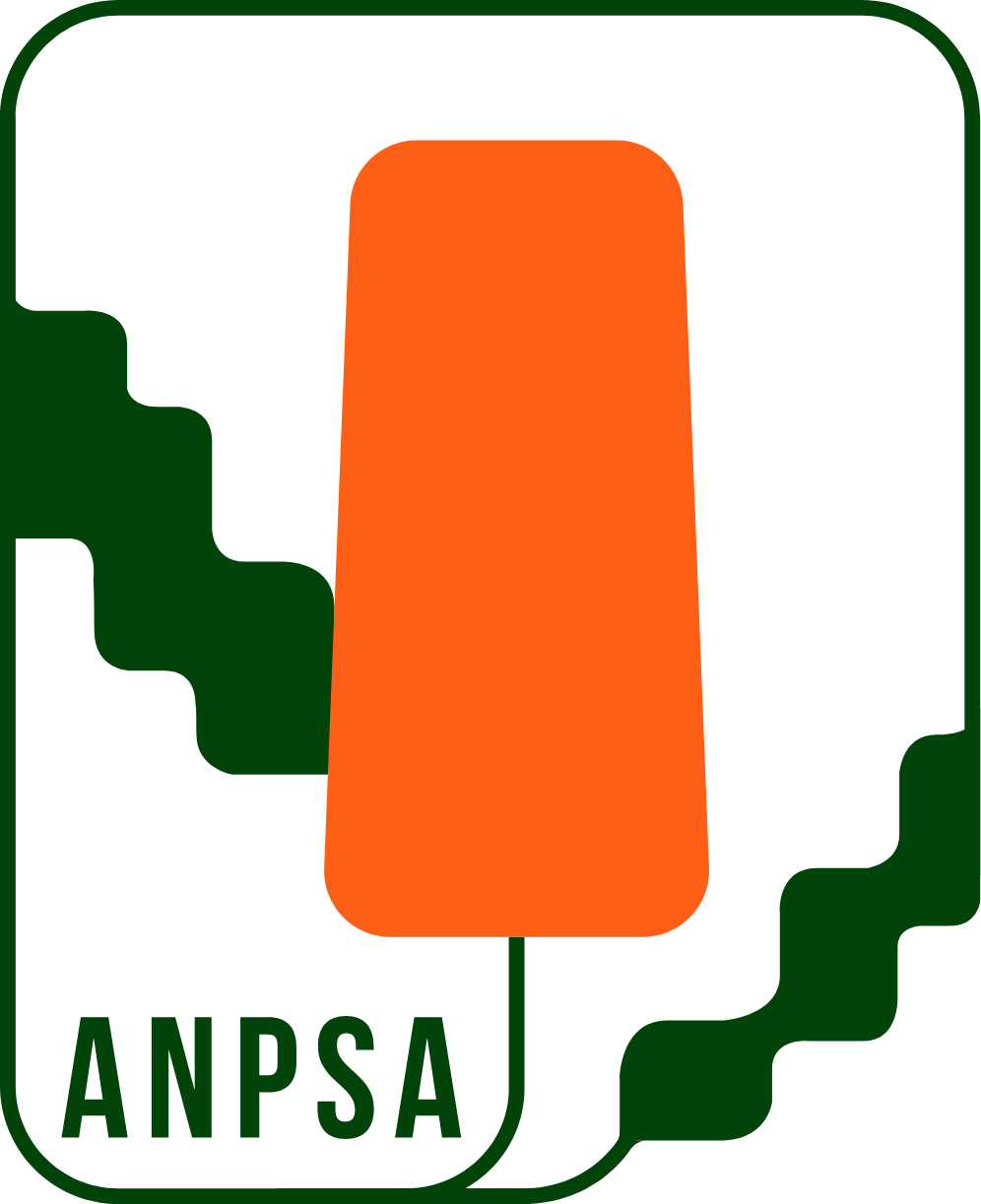Small Eucalypts for Small Gardens
Paul Kennedy
Everyone equates eucalypts with Australia but providing Australian people with advice on suitable eucalypts for their gardens, and for nurseries to stock suitable plants for sale seems to be sadly lacking.
How often have we seen large eucalypts planted in small gardens creating many problems such as too much shade, etc? Hence I put forward a list of small eucalypts suitable for small gardens or courtyards
based on climate and rainfall.
 |
| Eucalyptus kruseana Photo: Brian Walters |
The list (below) needs to be considered in conjunction with a number of criteria:
- Plants grown in soil as close to their natural growing conditions will do well. However, the further you move away from the ideal soil profile, the chance of success diminishes.
- Inland and high country eucalypts are generally more frost hardy than coastal eucalypts. The degree of frosts needs to be considered when selecting a eucalypt species.
- The effect of humidity on Western Australian species grown north of Jervis Bay, New South Wales, on the coast and adjacent ranges is unknown.
- Inland eucalypt species have adapted to growing in low rainfall areas and generally do not survive in high rainfall areas, eg E. orbifolia at Heathmont, Victoria, in a 900 min rainfall region survived but always looked unhappy and flowered poorly despite good drainage.
- Inland eucalypts generally need lots of hot weather to flower well. Eucalypts from high country/cool summers generally do not like the very hot summer days of the inland, and often show leaf burn and need regular water to survive.
The eucalypts I would wish to grow in a small garden would be:
1. E. youngiana
This mallee has everything you could wish for in a eucalypt. It has lovely light green, broad lanceolate leaves, which are not crowded. The bark peels revealing lovely tan coloured new growth. The flowers,
which are long lasting, can vary from yellow to pink to red and are up to 10 cms across. The buds have pointed caps, which can be deep pink in colour. The large seed capsules can be quite reddish brown in
colour and are very ornamental.
2. E. synandra
One of the very dainty species. Flowered this year at age 2. Originates from sandy soils near Shark Bay in Western Australia. The flowers change from cream to pink and hang down. The seed capsules are also ornamental
to look at.
 |
 |
|
| Left: Eucalyptus youngiana Right: Eucalyptus synandra Photos: Graeme O’Neill & Brian Walters |
||
3. E. diptera (or E. terebra)
When you see these species in the wild with their intense fluted, coppery trunks and bright green leaves, you just have to have one! Flower buds and seed capsules are in sessile clusters along the branches.
4. E. orbifolia, E. websteriana and E. kruseana
All from very dry regions. Have glaucous, orbicular foliage and yellow flowers, which makes them very attractive.
5. E. oldfieldii, E. burracopinnensis and E. sessilis
Generally form rounded bushes, have large cream to yellow flowers, large ornamental seed capsules with the rim thick and protruding and open green foliage. Buds can be very coppery in colour.
Suggested Small Eucalypts for Various Conditions
| Coastal and Adjacent Ranges | ||
| Temperate | Cool | High Country, Extremes |
| lehmanniana | gregsoniana | gregsoniana |
| obstans | burgessiana | vernicosa |
| burgessiana | apiculata | deuaensis |
| apiculata | cunninghamii | saxitilis |
| cunninghamii | approximans | |
| approximans | condonocarpa | |
| condonocarpa | pumila | |
| pumila | sturgessiana | |
| sturgessiana | infera | |
| infera | vernicosa | |
| cretata | deuaensis | |
| saxitilis | ||
| Inland Slopes and Adjacent Plains, Rainfall 400-600mm | ||
| oldfieldii | kingsmillii ssp. alatissima | “tetragona” spp. |
| lucens | nudicaulis | pachyloma |
| sessilis | deuaensis | platydisca |
| insularis | erectifolia | lateritica |
| exilis | pendens | sepulcralis |
| coronata | campaspe | preissiana |
| acies | youngiana | synandra |
| orbifolia | websteriana | albida |
| cretata | pimpiniana | kruseana |
| recondita | platypus ssp. congregata | incerata |
| pluricaulis ssp. porphyrea | grossa | diptera |
| terebra | misella | repleta |
| gillii | burracoppinensis | tetraptera |
| rigens | deflexa | normantensis |
| Far Inland, Rainfall <400mm | ||
| oldfieldii | lucens | sessilis |
| kingsmillii | nudicaulis | platydisca |
| youngiana | synandra | orbifolia |
| websteriana | cretata | pimpiniana |
| kruseana | grossa | campaspe |
| diptera | terebra | gillii |
| burracoppinensis | prominens | pilbarensis |
| Western Australian Species | ||
| “tetragona” spp. | pachyloma | insularis |
| pendens | sepulcralis | coronata |
| preissiana | acies | albida |
| platypus ssp. congregata | desmondensis | densa ssp. improcera |
| pluricaulis ssp. porphyrea | rigens | erectifolia |
| lateritica | exilis | |
From the newsletter of ASGAP’s Eucalyptus Study Group, February 2005.For more information on the eucalypts, see the Eucalyptus, Corymbia and Angophora section of the website.
 Australian Native Plants Society (Australia)
Australian Native Plants Society (Australia)